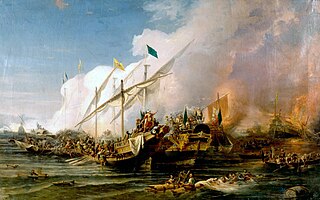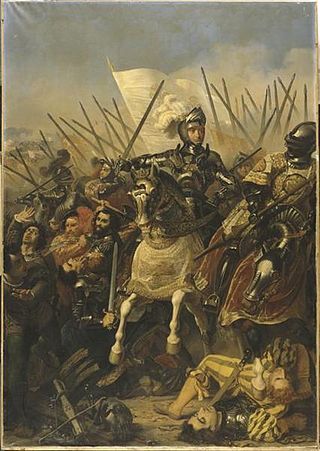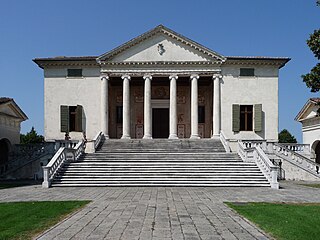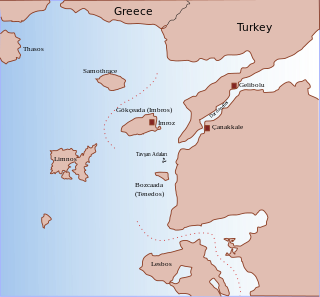
The Battle of Preveza was a naval engagement that took place on 28 September 1538 near Preveza in the Ionian Sea in northwestern Greece between an Ottoman fleet and that of a Holy League. The battle was an Ottoman victory which occurred in the same area in the Ionian Sea as the Battle of Actium in 31 BC. It was one of the three largest sea battles that took place in the sixteenth century Mediterranean, along with the Battle of Djerba and the Battle of Lepanto.

The Battle of Agnadello, also known as Vailà, was one of the most significant battles of the War of the League of Cambrai and one of the major battles of the Italian Wars.

The War of the League of Cambrai, sometimes known as the War of the Holy League and several other names, was fought from February 1508 to December 1516 as part of the Italian Wars of 1494–1559. The main participants of the war, who fought for its entire duration, were France, the Papal States, and the Republic of Venice; they were joined at various times by nearly every significant power in Western Europe, including Spain, the Holy Roman Empire, England, the Duchy of Milan, the Republic of Florence, the Duchy of Ferrara, and the Swiss.

The Battle of Focchies was a significant naval engagement that took place on 12 May 1649, in the harbour of Focchies, Smyrna between a Venetian force of nineteen warships under the command of Giacomo da Riva, and an Ottoman force of eleven warships, ten galleasses, and seventy-two galleys, with the battle resulting in a crushing victory for the Venetian fleet. The battle was an episode in the Cretan War from 1645 to 1669 between the Venetian Republic and the Ottoman Empire over dominance of various territories in the Mediterranean Sea. The war was one in a series of wars between the two warring powers, which contested for control of the Adriatic and Mediterranean trade routes. The primary territory that was contested during the war was Crete, the largest and most profitable of the overseas holdings of the Venetian Republic. The battle came after a squadron of Venetian ships under the command of Giacomo da Riva, a Venetian admiral, came to the rescue of the blockading Venetian force in the Dardanelles Straits, after the blockade had run into unexpected weather conditions and many ships sunk as a result.

The province of Rovigo is a province in the Veneto region of Italy. Its capital is the city of Rovigo. It borders on the north with the provinces of Verona, Padua and Venice, on the south with the province of Ferrara, on the west with the province of Mantua, and on the east with the Adriatic Sea.

The Third Battle of the Dardanelles in the Fifth Ottoman-Venetian War took place on 26 and 27 June 1656 inside the Dardanelles Strait. The battle was a clear victory for Venice and the Knights Hospitaller over the Ottoman Empire, although their commander, Lorenzo Marcello, was killed on the first day.
This battle, which took place on 16 May 1654, was the first of a series of tough battles just inside the mouth of the Dardanelles Strait, as Venice and sometimes the other Christian forces attempted to hold the Turks back from their invasion of Crete by attacking them early.

Niccolò di Pitigliano (1442–1510) was an Italian condottiero best known as the Captain-General of the Venetians during the Most Serene Republic's war against the League of Cambrai. He was a member of the powerful feudal family of the Orsini, belonging to its Pitigliano line.

Polesine is a geographic and historic area in the north-east of Italy whose limits varied through centuries; it had also been known as Polesine of Rovigo for some time.

The naval Battle of Zonchio took place on four separate days: 12, 20, 22, and 25 August 1499. It was a part of the Ottoman–Venetian War of 1499–1503.
The War of Ferrara was fought in 1482–1484 between Ercole I d'Este, Duke of Ferrara, and the Papal forces mustered by Ercole's personal nemesis, Pope Sixtus IV and his Venetian allies. Hostilities ended with the Treaty of Bagnolo, signed on 7 August 1484.
The military history of the Republic of Venice started shortly after its founding, spanning a period from the 9th century until the Republic's fall in the 18th century.

The Wars in Lombardy were a series of conflicts between the Republic of Venice and the Duchy of Milan and their respective allies, fought in four campaigns in a struggle for hegemony in Northern Italy that ravaged the economy of Lombardy. They lasted from 1423 until the signing of the Treaty of Lodi in 1454. During their course, the political structure of Italy was transformed: out of a competitive congeries of communes and city-states emerged the five major Italian territorial powers that would make up the map of Italy for the remainder of the 15th century and the beginning of the Italian Wars at the turn of the 16th century. They were Venice, Milan, Florence, the Papal States and Naples. Important cultural centers of Tuscany and Northern Italy—Siena, Pisa, Urbino, Mantua, Ferrara—became politically marginalized.

Polesella is a comune (municipality) in the Province of Rovigo in the Italian region Veneto, located about 70 kilometres southwest of Venice and about 11 km (7 mi) south of Rovigo.
Kemal Reis was an Ottoman privateer and admiral. He was also the paternal uncle of the famous Ottoman admiral and cartographer Piri Reis, who accompanied him in most of his important naval expeditions.
An incomplete series of events, births and deaths which occurred in Italy in 1509:

The Venetian navy was the navy of the Venetian Republic which played an important role in the history of the republic and the Mediterranean world. It was the premier navy in the Mediterranean Sea for many centuries between the medieval and early modern periods, providing Venice with control and influence over trade and politics far in excess of the republic's size and population. It was one of the first navies to mount gunpowder weapons aboard ships, and through an organised system of naval dockyards, armouries and chandlers was able to continually keep ships at sea and rapidly replace losses. The Venetian Arsenal was one of the greatest concentrations of industrial capacity prior to the Industrial Revolution and responsible for the bulk of the republic's naval power.

The Battle of Gallipoli occurred on 29 May 1416 between the fleets of the Republic of Venice and the Ottoman Empire off the port city of Gallipoli, the main Ottoman naval base. The battle was the main episode of a brief conflict between the two powers, resulting from Ottoman attacks against possessions and shipping of the Venetians and their allies in the Aegean Sea in 1414–1415. The Venetian fleet, under Pietro Loredan, was charged with transporting a Venetian embassy to the Ottoman sultan, but was authorized to attack if the Ottomans refused to negotiate. The subsequent events are known chiefly from a detailed letter written by Loredan after the battle.

The Battle of Trapani took place on 23 June 1266 off Trapani, Sicily, between the fleets of the Republic of Genoa and the Republic of Venice, as part of the War of Saint Sabas (1256–1270). During the war, the Venetians held the upper hand in naval confrontations, forcing the Genoese to resort to commerce raiding and avoiding fleet battles. In the 1266 campaign, the Genoese had an advantage in numbers, but this was not known to the Genoese commander, Lanfranco Borbonino. As a result, the Genoese tarried at Corsica until the end of May. The Venetian fleet under Jacopo Dondulo, was left to sail back and forth awaiting the appearance of the Genoese fleet in the waters around southern Italy and Sicily. Fearing that the other side had more ships, both sides reinforced their fleets with additional ships, but the Genoese retained a small numerical advantage.

The War of Padua was a conflict in 1404–1405 between the Republic of Venice and the Carrarese lordship of Padua. In the power vacuum produced by the death of the Duke of Milan, Gian Galeazzo Visconti, in 1402, Francesco II da Carrara endeavored to expand into the Veneto and capture cities held by Visconti troops. These designs alarmed Venice, which allied with Milan to counter the common threat posed by the Carrarese state, and for the first time adopted a policy of direct intervention in the affairs of its hinterland.
















